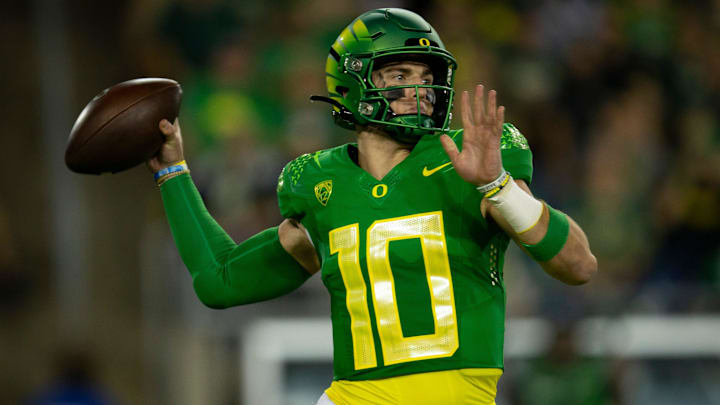Oregon has a tremendous tradition at quarterback. The Ducks have had seven first-round draft picks at QB in their history:
George Shaw1955 (overall No. 1)
Chris Miller 1987 (No. 13)
Akili Smith 1999 (No. 3)
Joey Harrington 2002 (No. 3)
Marcus Mariota 2015 (No. 2)
Justin Herbert 2020 (No. 6)
Bo Nix 2024 (No. 12)
That list doesn't include Pro Football Hall of Famers Norm Van Brocklin, picked in the 4th round by Los Angeles in 1949 or Dan Fouts, selected in the third round by San Diego.
It also leaves out some perfectly wonderful, outstanding QBs at UO who weren't premium pro prospects. Bob Berry went in the 11th round to Philadelphia. Bill Musgrave wasn't picked until the 4th round by Dallas.
Dillon Gabriel landed in the third, nabbed by Cleveland two rounds ahead of Shedeur Sanders. The Jets picked Kellen Clemens 49th overall in round two, and he played 11 seasons in the league.
Of course, stellar Oregon quarterbacks like Darron Thomas, Jeremiah Masoli, Vernon Adams and Danny O'Neil weren't drafted at all. Following a devastating knee injury, 2007 Heisman candidate Dennis Dixon fell to the fifth round and only lasted three seasons with Pittsburgh.
The NFL isn't the arbiter of everything. Some great college quarterbacks hardly make a nickel in the league. The games, play styles and position requirements, college to pro, simply aren't the same.
JUSTIN HERBERT THROWS ACROSS THE FIELD WHILE HANGING IN THE AIR, A SEAM FOR A TOUCHDOWN,
— MLFootball (@_MLFootball) November 18, 2024
😱😱😱
HERBERT IS DEALING RIGHT NOW. PLAYING LIKE THE BEST QB IN THE LEAGUE.
pic.twitter.com/DK3vLQnVCu
It's also fun to think about how devastating Akili Smith or Herbert might have been in a Will Stein offense. The blood boils thinking how ill-used Herbert was in the unimaginative, run-first game plan the Ducks used over his four years.
A quarterback keeper at the goal line cost him half a season as a sophomore.
The original Mount Rushmore honors George Washington, Thomas Jefferson, Theodore Roosevelt and Abraham Lincoln. American sculptor Gutzon Borglum and his son Lincoln set out to depict the four critical stages of development in the American story, birth, growth, development and preservation.
Following that model, the four QBs who belong on a hypothetical Rushmore of Oregon signal callers would be:
Dan Fouts
Bill Musgrave
Marcus Mariota
Justin Herbert
Shy Huntington, Van Brocklin and Shaw came before Fouts, even Robert "Bobby" Robinson, Oregon's first Black quarterback in 1927-1929 and one of the first Black football players at UO, just a few years after the KKK elected the Oregon governor Walter Pierce in 1922.
But Fouts was the first Oregon quarterback to exemplify the attitude and identity of the Fighting Ducks, the never-out-of-it, throw-the-rock tradition of gunslingers and aerial artists that have graced the position in Eugene.
The rules, the ball, and the offenses were different then, but Fouts connected with a pair of 1,000-yard receivers in his day and threw for 5,995 yards and 37 touchdowns on teams that didn't have a third of the star power Oregon has now.
Similar to uniforms that Dan Fouts wore at Oregon! https://t.co/8BQtOQsi4i pic.twitter.com/9bx0Ysfc0t
— Coaches Hot Seat 🔥 (@CoachesHotSeat) October 1, 2023
Reggie Ogburn made another undermanned Oregon squad competitive in '79 and '80, throwing for 2,162 yards, rushing for 1,171. He'd have been lethal in a spread offense. So too Smith in the 1990s.
Musgrave gets the nod for the second spot on the Oregon QB Mount Rushmore because he represents growth. He took the Ducks to their first bowl games in 36 years, their first back-to-back eight-win seasons ever.
He took the Oregon downfield passing attack to a new level with 7,631 yards and 55 TDs.
Bill Musgrave, Oregon. Took a habitual 4-7, 5-6 program to respectability getting them a bowl bid at 7-4 in 1989, their first in 32 years. Then did it again the next year. He really started the Oregon football machine which most think started 10 years later. pic.twitter.com/Jumgtaa69h
— Bryan Beban (@bkbeban) June 28, 2023
Harrington stands as probably the most beloved of Oregon quarterbacks after Mariota, an inspirational leader who won all three of his bowl games and piloted the Webfoots to their first-ever final No. 2 ranking in 2001.
But as the symbol of development he takes a back seat to the Flyin' Hawaiian, who won the Quack Attack's only Heisman Trophy and compiled a 36-5 record as a starter with three top ten finishes.
Mariota threw for 10,796 yards and 105 touchdowns, ran for 2,237 yards and 29 touchdowns, and he did it with a class, humility and gratitude that set the standard for all time. He practically deserves a Rushmore to himself.
8️⃣ DAYS UNTIL OREGON FOOTBALL #GoDucks #M8
— Geaux Ducks (@GeauxDuck) August 25, 2023
2014 Heisman Trophy Winner - Marcus Mariota pic.twitter.com/ElACR5NAe7
In the fourth spot a fan could pick a half dozen Ducks. But Herbert played four seasons and won a Rose Bowl and he did as much as anyone to preserve the tradition of great quarterback play at Oregon and continue the tradition of how a Duck QB should conduct himself and lead under pressure.
He helped rebuild a winning tradition that had crumbled over three coaching changes in five years.
Nix and Gabriel were wonderful. Both completed over 72% of their passes and earned trips to New York. It would have been great to have had either of them for four full seasons, but they stepped in, established themselves as leaders and won at a high level.
Wholesome: Justin Herbert and Bo Nix were at Oregon’s pro day today to support star QB Dillon Gabriel.
— Dov Kleiman (@NFL_DovKleiman) March 18, 2025
The future faces of the NFL 👀 pic.twitter.com/EjfRhLxhfk
